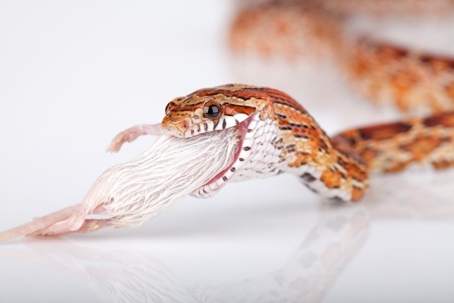What Do Corn Snakes Eat?
In the wild, corn snakes (Pantherophis guttatus) are opportunistic and adaptable predators. Their diet consists primarily of small vertebrates, and they rely heavily on their keen sense of smell and heat-sensing abilities to locate prey. Here's what corn snakes eat in their natural habitat:
Primary Diet
Rodents: Mice and rats are the most common food source for adult corn snakes. They primarily prey on nestling or juvenile rodents, which are easier to subdue and swallow. This helps regulate wild rodent populations, making corn snakes ecologically beneficial.
Birds and Bird Eggs: Corn snakes will raid bird nests, especially those close to the ground or in low shrubs. They consume fledglings (young birds) and eggs, especially during nesting season. Eggs are swallowed whole, and their powerful digestive system breaks down the shell internally.
Reptiles and Amphibians: They occasionally consume lizards, frogs, and toads, especially juveniles. Hatchling and juvenile corn snakes are more likely to feed on these smaller prey items.
Secondary and Opportunistic Diet
Other Snake Eggs: Juvenile corn snakes sometimes eat the eggs of other reptiles, including snakes and lizards, if accessible.
Small Mammals: In some environments, corn snakes may feed on shrews, voles, or even small bats (if roosts are accessible, such as in barns or attics).
Insects (Rarely): While not a staple, newly hatched corn snakes may eat large insects or arthropods if vertebrate prey is scarce. However, this is relatively uncommon and not a significant part of their diet.
Feeding Behavior and Hunting Techniques
Constriction: Corn snakes are non-venomous constrictors. They subdue their prey by coiling around it and suffocating it before swallowing it whole.
Nocturnal/Crepuscular Hunters: Most active during dawn, dusk, or at night, which aligns with the activity patterns of many of their prey species.
Ambush and Active Foraging: They can both lie in wait and actively search for prey, depending on habitat and availability.
Habitat Influence on Diet
In forested areas, bird and rodent prey are more common.
In agricultural zones or near human dwellings, they may rely more on rodents and even raid poultry nests for eggs.
In swampy or humid areas, amphibians may become a more prominent food source, particularly for juveniles.
Corn snakes are versatile feeders whose diet in the wild primarily consists of small mammals (especially rodents), birds, and bird eggs, supplemented by reptiles and amphibians. Their diet shifts as they mature, with younger snakes targeting smaller, easier prey and adults capable of taking down larger animals. Their role in controlling pest populations makes them beneficial to natural and agricultural ecosystems.

